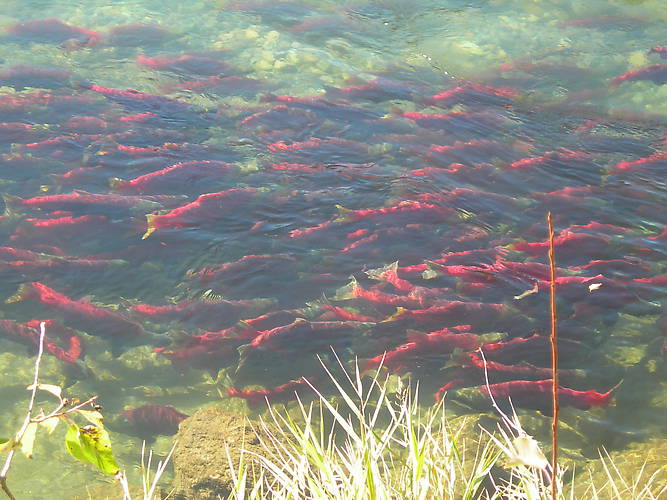
It truly boggles the mind. A veritable sea of red. These are some of the 34 million Sockeye headed up river to spawn. The height of the Sockeye spawning run will coincide with the Canadian Thanksgiving Holiday. Somehow, that just seems appropriate. When Bev and I went to view the run Oct 1st, there were approx. 26 million fish in the system, with another 8 million still to make the journey upstream. This is the largest sockeye return since 1913, and caught the experts admitting they had not calculated such a large return to the river system. This is huge for the sockeye, as many experts were forecasting gloom and doom for the future of the species. Considering that 90% of the 50% that hatch will not make it back to the sea to grow and return in 4 years to spawn. The survival rates are exceedingly low, but for tens of thousands of years, they have managed to survive and fight their way past commercial fishing boats, sports fishermen, the Native Ceremonial food fishery, natural obstructions such as landslides, and man made obstructions such as power dams, and those caused by railroads blasting rights of way. One classic example of this is the Hell's Gate narrows on the Fraser River north of Hope, B.C. Due to blasting by the railways, millions of tons of rock tumbled into and partially blocked the Fraser, causing a nearly impassible obstruction. Finally fish ladders were installed which allowed the 6 species of salmon to again migrate past the Hells gate blockage in substancial numbers. The Sockeye is reputed to be the best eating of all the salmon, and it is heart warming to be able to witness this spectacular display of nature at it's best. The Sockeye salmon will be in the river until the end of October, at which point most will have spawned and died. Unlike the Atlantic east coast salmon which return each year to spawn, west coast salmon spawn at the end of their 4 year [average] life cycle, and then die. Their bodies decay, creating food for wildlife and birds, and nutrients in the water for the oncoming generations of salmon. Other species of salmon such as Coho, Chinook, Pink, Steelhead and Chum migrate upstream at various times of the year, but generally there is nothing to compare to the spendor of the Sockeye with it brilliant red body and green head. This is truly nature showing off her fall colours |